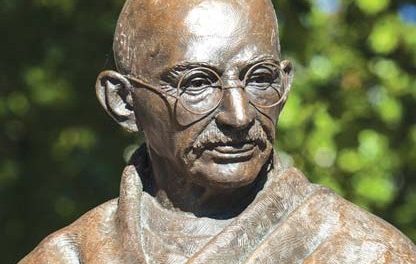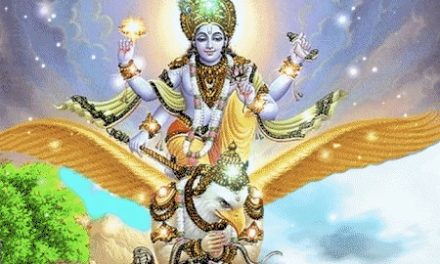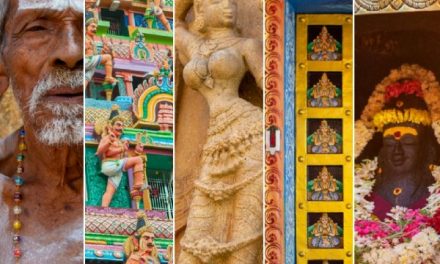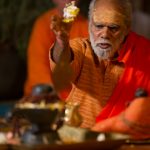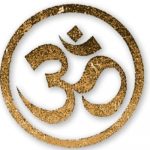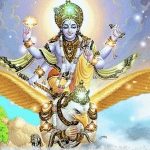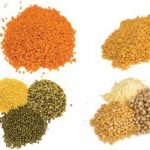‘Holi’day! The Festival of Colour
By Anisha
There can hardly have been a more colourful opening to a month than March 2018, when Holi fell on the very first day of the month. The festival of colours is celebrated in India and all along the latitude of the world wherever Indian tradition is cherished.
Celebrations start on the eve of Holi, called ‘Holika Dahan’, followed by ‘Rangwali Holi’ the next day, and are worthy of special attention as they are braided closely by religious, scientific, spiritual and philosophical outlooks.
 The event begins in the evening with a bonfire named after demoness Holika. People gather around to perform rituals and offer prayers with an intention to purify themselves, burning away their vices just as Holika was burnt. In contrast, the second part of the festival is a fun-frolic-fight combination when the colour riot begins!
The event begins in the evening with a bonfire named after demoness Holika. People gather around to perform rituals and offer prayers with an intention to purify themselves, burning away their vices just as Holika was burnt. In contrast, the second part of the festival is a fun-frolic-fight combination when the colour riot begins!
People transcend boundaries of age and status becoming mischievous enough to playfully smear and spray colours on each other, not sparing a single passerby as a mark of spreading victory, unity and love. This pray-play element of Holi symbolises the serious-funny sides of life making the festivity a wholesome experience.
Across the country folklores differ from each other, yet they all convey deep messages when seen through the eyes of yogic and vedantic philosophies.
Holi stories and their yogic inference
India, with Her multicultural persona, does not celebrate a festival with one unanimous story, reason, style and attitude. As a result, across the country folklores differ from each other, yet they all convey deep messages when seen through the eyes of yogic and vedantic philosophies.
Narasimha version
The Narasimha version of Holi commemorates the restoration of Dharma (righteousness) by Lord Narasimha, a man-lion avatar of Lord Narayana, whose purpose was to kill the demon King Hiranyakashibu and save his devotee Prahlada, the King’s own son. Young Prahlada, an ardent devotee of Lord Narayana, was unyielding to the pressures of his father who enforced everyone to worship him chanting “Hiranyaya Namah”.
Instead Prahlada incessantly adhered to “Om Namo Narayanaya” as a mark of his unconditional devotion. Unable to bear it, the King subjected Prahlada to several cruel punishments, all of which proved ineffective. Finally, Holika, Prahlada’s evil aunt, tricked him into sitting on a pyre with her. Holika was wearing a fire-immune cloak, while Prahlada was not. As the flames roared, the cloak flew from Holika and encased Prahlada who survived while Holika burned.
Then as a proof of His omnipresence, Lord Narasimha made a dramatic appearance from a pillar of the King’s court – yard and killed Hiranyakashibu. Inference: The ‘I-my’ issue of the mind is handled in this lore. The demon King Hiranyakashibu metaphorically stands for ego (Ahamkara, ‘I’ ness) which always tries to hold itself in a supreme state (expecting to be worshipped).
With the help of his sister Holika (mamakara, ‘my’ ness), he tries to destroy the independent nature of Prahlada (the soul) by forcing it to identify with the ego. But with one pointed devotion the soul disengages itself from the ‘I-my’ issue and always surrenders itself to the Source (Lord Narayana). The Holika bonfire symbolises victory achieved through Bhakti (devotion) of good over evil, of Prahlada over Hiranyakashibu, of soul over ego.
Krishna version
Radha is the dearest devotee of Lord Krishna (avatar of Vishnu), who won His heart not through penance or prayer, but by total surrender. She shows Madhurya bhava (beloved attitude) towards her Lord. Krishna, known for his dark skin, despaired whether the fair-skinned Radha would like him because of his appearance.
His mother, tired of the desperation, asks him to approach Radha and colour her face in any colour he wanted. Krishna does this which leads to Radha and Krishna becoming one as a couple. Ever since, the playful colouring of Radha’s face has been commemorated as Holi. Inference: The story strikes a rare note on the bhakti scale.
While it is usual for a devotee to hold on to God as would a baby monkey to its mother (Markata Nyaya), this story gives a 360 degree twist by leaving God himself in a yearning state wondering “Will my devotee love me for what I am?” While this highlights the simplicity of Lord Krishna it also stays in tune with the Vaishnavite cult’s belief that whenever Vishnu finds a devotee like Radha who is an epitome of total surrender, He finds Him in a state of advantage and would Himself hold on to the devotee as would a mother cat to its kitten (Marjara Nyaya). Krishna and Radha becoming a couple symbolises the union of individual self with the universal self.
Shaivite version
In South India Holi is celebrated as a mark of the return of Kama, the God of Love. The story goes this way: Lord Siva was in yoga and deep meditation. But Goddess Parvati wanted to bring Siva back into the world and get married to Him, though Siva does not pay any attention. But if Siva does not marry, he will father no children and the demon, Taraka, will not be killed. She seeks help from the god of love called Kama. The love god shoots arrows at Siva.
This provokes Siva who opens his third eye and burns Kama to ashes, upsetting both Kama’s wife Rati (Kamadevi) and Parvati. Rati performs her own meditative asceticism for forty days, upon which Siva under – stands, forgives out of compassion and restores the god of love. This return of the god of love is celebrated as Holi. Inference: Here Siva represents a ‘one pointed mind’ which shows detachment from worldly desire (kama) achieved through meditation.
When his meditation is disturbed, his third eye opens (Ajna chakra, the seat of discriminative intelligence) and kills desire. Yet from a karma yogic point of view such an untimely dispassion could come in the way of discharging one’s destined duties. Goddess Parvati (representing Prakriti, Nature) symbolises the force that draws the mind (Siva) towards a desire for a good cause rather than personal gain.
The story highlights the importance of adhering to the four proper goals of human life, namely dharma (righteousness), artha (material), kama (desire) and then moksha (liberation). Having realised that kama precedes moksha, the mind (Siva) then steps out of seclusion, gives life to desire (Kama) by yielding to the forces of nature (marrying Goddess Parvathi) in order to fulfil the destined duty.
Holi and its spiritual implication
The pattern of Holi celebration may precisely be superimposed upon the spiritual pattern of life. Yoga explains how each chakra has a specific colour and corresponds to a certain level of understanding of life. The purpose of yoga is to transcend the colourful lower chakras and move the Kundalini energy up to the higher centres until it reaches the final plane, Sahasrara, a colourless/golden white zone. The creator is colourless but creativity is colourful. In advaitic terms, Brahman (Universal Consciousness) is colourless but Maya (illusion) is colourful. In the festival of Holi, the concept of Maya is drama – tised through the play of colours: how it spreads and brings everyone under its charm. The later deliberate washing away of the stubborn colours with meticulous effort so as to return to one’s original appearance probably symbolises the want of every soul to disengage itself from the colourful illusory world so as to return to the Spirit after ages of spinning within the wheel of birth and death.
Science behind Holi – a rational view
Why is Holi celebrated on a particular day and in this fashion?
1. Welcoming a new season: As per the Indian calendar, the full moon day in the month of Phalgun, which marks the beginning of the spring season, a period between end of winter and advent of summer, is the day of Holi. In the Gregorian calendar, this falls between mid-February and mid-March.
2. Social: In Swami Sivananda’s own words “The social element during Holi is the uniting of the great and the small, of the rich and the poor. People stand in the streets and sprinkle coloured water on any man who passes by, be he a rich man or an officer. There is no restriction on this day. It is like the April Fool’s Day of the Europeans.”
3. Health concerns: The seasonal shift induces microbial growth in the atmosphere as well as in the body. When Holika is burnt, the temperature of the nearby area rises to around 50-60 degrees Celsius. When people go around the bonfire/pyre, the radiating heat is claimed to kill the heat susceptible microbes in the body and cleanse the systems.
4. Promotive: In some parts of the country, after Holika Dahan (burning of Holika) people put ash on their forehead to absorb moisture in order to prevent sinusitis and also mix Chandan (paste of sandal wood) with the young leaves and flowers of the mango tree and consume it. It is believed to promote good health.
5. Psychosomatic: It is also quite natural to experience Tamas (lethargy) during seasonal change. It is to counter this laziness that Holi celebrations are designed to be Rajasic. The singing of kirtans, musical instruments, sight of vibrant colours and the physical movement in playfully throwing colours at each other psychologically works in synergy to combat tamas.
6. Vitality and Rejuvenation: Colours play a vital role in the fitness of the human body. Deficiency of a particular colour could cause an ailment and can be cured when that colour element is supplemented either through diet or medicine. In ancient times, when people started playing Holi, the colours used by them were made from natural sources like turmeric, Neem, Palash (Tesu) etc. The colour powders made from these natural sources have a healing effect on the human body. They have the effect of strength – ening the body.
Organic sources of colours used in ancient times:
Green – Leaves of henna, bilva, gulmohur tree, spinach,
Yellow – Turmeric powder, bael fruit, marigold, sunflowers, daffodils.
Red – Red sandal wood, red pomegranate, tesu tree flowers, dried hibiscus.
Saffron – Flowers of tesu tree (palash), a mix of lime with turmeric powder.
Indigo – Indigo, indian berries, species of grapes, blue hibiscus.
Purple – Beetroot. Brown – Dried tea leaves.
Black – Dried gooseberries (amla).
Colours or chemicals?
An unfortunate outcome of chemical science is the convenient rise of synthetic colours despite the health hazards and a brutal decline of herbal powders, attributed to cost. The synthetic colours available in the market comprise of toxic components such as lead oxide, diesel, chromium iodine and copper sulphate, all of which are suspicious agents and not friendly to the skin and health.
Hopefully the increasing awareness around organic products will restore natural colours back to stores at an affordable price in the foreseeable future.
Anisha Manjeni L. is a former staff at the Sivananda Yoga Vedanta Meenakshi Ashram, Madurai, India where she completed the Sivananda TTC and ATTC. She teaches the Bhagavad Gita and chanting classes during some of the TTC at the Meenakshi Ashram.


